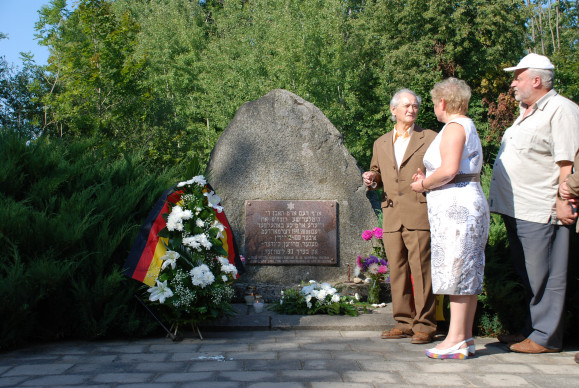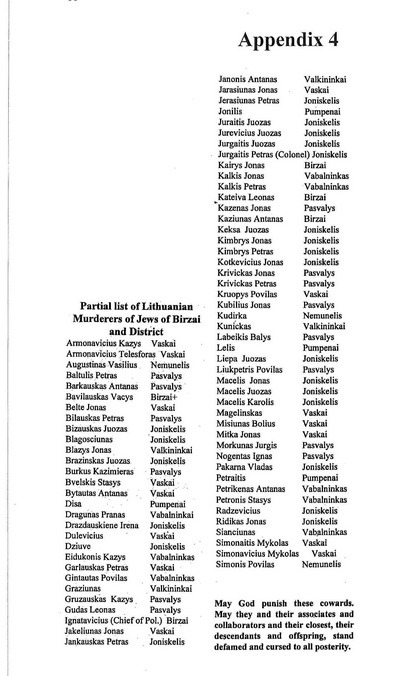Birzai und seine Juden
Die kleine Stadt Birzai hatte im Jahr 1897 4413 Einwohner, wovon 57 % Juden waren (davon mehr unter "jüdische Geschichte Birzais").
Der alte jüdische Friedhof in Birzai ist der größte in ganz Litauen.
Im "Sela Heimatmuseum", beheimatet in der Birzaier Burg, erinnert eine einzige kleine Vitrine an die jüdische Kultur Birzais.
In der Abteilung über den Hitler-Stalin-Pakt, der sowjetischen Besatzung und den Deportationen der Jahre 1941 nach Sibirien, gibt es ein Foto von Juden , die die Regierung Paleckis und den Pakt mit der Sowjetunion bejubeln.
Ich versuche die "Rolle" der Juden in den Jahren 1940 und 1941 zu untersuchen und würde mich über Anregungen und Unterstützung freuen.

Am 8. August 1941 kam das Aus für die Litauer jüdischen Glaubens. Die deutschen Einsatzkommandos ließen mit Hilfe litauischer Freiwilliger (oft Partisanen oder Weißarmbindler vom Aufstand gegen die sowjetische Besatzung) die Juden von der Stadt in den Astravas-Wald nordöstlich vom Sirvenos-See laufen. Zuvor hatten jüdische Männer Gruben ausheben müssen.
In der United States Holocaust Memorial Museum Encyclopedia of Camps and Ghettos steht zu den Morden in Birzai :
"On July 26, 1941 the town authorities ordered all Jews to move into the ghetto, for which purpose they have designated several small streets in the vicinity of the synagogue. Any Lithuanians living in this area were also forced to move out, exchanging houses with Jews who moved in. Barbed wire surrounded the area and armed Lithuanian policemen guarded it. A lack of resources caused widespread hunger in the ghetto. The birzai ghetto existed only about two weeks. On August 4, 1941, a group of about 500 Jewish men were sent out of the ghetto with spades, while the women, children and elderly were locked up in the synagogue, guarded by Lithuanian auxiliary police (wearing white armbands). The men dug a ditch more than 30 meters longand 2 meters wide, which took them three day. Then on August 8, German forces of Einsatzkommando 3, assisted by Lithuanian auxiliaries, surrounded the ghetto. The Jews were told that they would be send to Palestine and were ordered to assemble. The men were marched out to the ditches first and were beaten and cursed on the way. Dr. Levin, a local phycician, refused to go and was shot on the spot. They were taken to the ditches in the Astravas Forest, about 3 kilometers outside the town.
About one hour later, the women and children were marched off in the same dicection, weaving good-bye to local aquaintances. At this time the sound of shooting could allready be heard in the distance. Jews from the hospital were taken to the killing site on trucks. At the ditch the Jews were made to undress and then shot in the graves in groups of 10, piled up on top of each other. Some of the Jews had their gold teeth ripped out of their mouths. The murderers drank heavily during the Aktion [sic].
In total about 2.400 Jews (720 men, 780 women and 900 children) were murdered. Several days later about 90 Lithuanians were shot into the same mass grave for alleged collaboration with the Soviets. After the Aktion [sic], local Lithuanians looted property from the empty ghetto, handing only the most valuable items on to the Germans. In September 1941, Einsatzgruppe A reported that Kreis Birsen was "cleansed of Jews" (judenrein).
One Jewish girl, Helena Nosowa, is known to have escaped from the murder Aktion and survived with the aid of local Lithuanians until the arrival of the Red Army. After the war, Jewish survivors and returnees to Birzai placed a memorial at the site of the mass killings."
Sources
Information on the fate of the Jews of Birzai during the Holocaust can be found in the following publications: (z.B. Henry Tabakin: Only Two Remained (1973) und viele weitere Quellen)
Die einzigen Überlebenden dieser Zeit waren die von den Sowjets (bei den Massendeportationen) im Jahre 1940 nach Sibirien Deportierten und Juden, die in der russischen Armee dienten. Über das Leben von Šeftel Melamed später mehr.
Am Ort des Massakers ist heute eine Gedenkstätte

Šeftel Melamed, seine Tochter Leta Vainoriene und Antanas Seibutis

Bürgermeisterin I. Varziene, Vertreter der deutschen Botschaft in Vilnius und Birzaier Schüler
Denkmal mit Namen der ermordeten Juden
Heute ist dort eine Gedenkstätte. Im Sommer 2011, als eine Gruppe engagierter Christen aus Deutschland den jüdischen Friedhof in Ordnung brachten, wurde dort im Beisein von Sheftel Melamed, der Birzaier Bürgermeisterin Varziene und Vertretern der deutschen Botschaft ein Kranz niedergelegt.
Unvollständige Liste der Mörder am Massaker in Birzai und Umgebung:

(Quelle der Namen: Josef Rosin oder bei Gordi_Zionelder gibts weitere Listen)
Den kompletten Text über die Zeit der Juden in Birzai lesen sie auf deutsch bei Jüdisches Leben in Birzai
